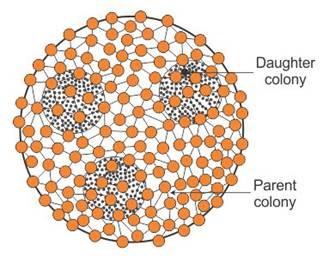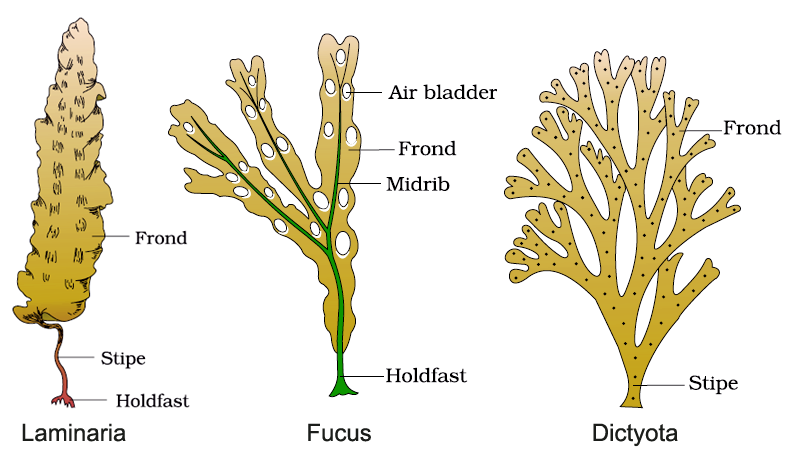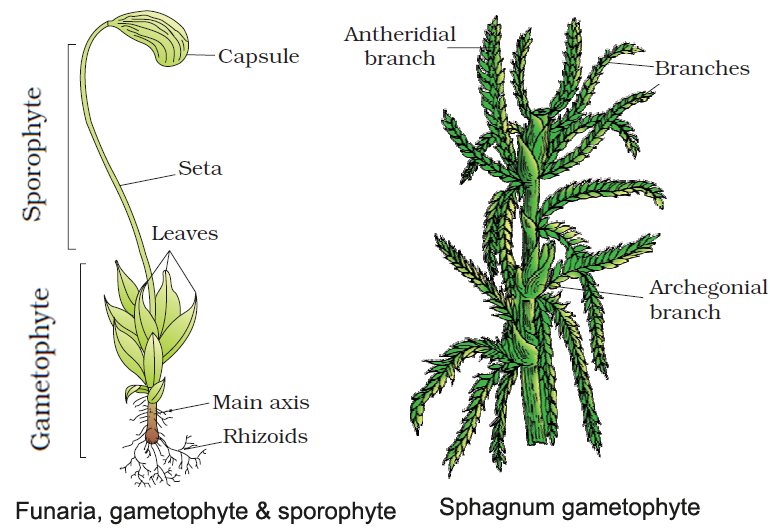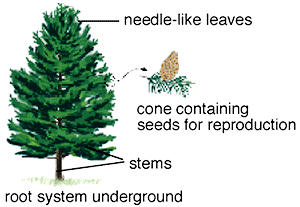Plant Kingdom
Algae:
- They are ^^chlorophyll-bearing, simple, thalloid, autotrophic and largely aquatic^^ (both fresh water and marine) organisms.
- They occur in a variety of other habitats: moist stones, soils and wood.
- Some of them also occur in association with %%fungi (lichen) and animals.%%
- The form and size of algae are highly variable, ranging from colonial forms like Volvox, and the filamentous forms like Ulothrix and Spirogyra.
- The algae reproduce by vegetative, asexual and sexual methods.
- Vegetative reproduction is by @@fragmentation@@@@.@@
- Each fragment develops into a @@thallus.@@
- Asexual reproduction is the production of different types of spores, the most common being the ==zoospores.==
- They are flagellated (motile) and on germination give rise to new plants.
- Sexual reproduction takes place through the fusion of two gametes.
- These gametes can be ^^flagellated and similar in size (as in Ulothrix)^^ or on-flagellated (non-motile) but similar in size (as in Spirogyra). Such reproduction is called ==isogamous.==
- Fusion of two gametes dissimilar in size, as in species of Eudorina is termed anisogamous.
- Fusion between one large, nonmotile (static) female gamete and a smaller, motile male gamete is termed ==oogamous as in Volvox, Fucus.==
Importance of Algae:
- At least half of the total carbon dioxide fixation on earth is carried out by algae through photosynthesis.
- Being photosynthetic they increase the level of dissolved oxygen in their immediate environment.
- They function as primary producers of energy-rich compounds which form the basis of the food cycles of all aquatic animals.
- Certain marine brown and red algae produce large amounts of @@hydrocolloids (water-holding substances)@@ @@like@@ @@algin and carrageen@@@@.@@
- Porphyra, Laminaria and Sargassum are among the 70 species of marine algae ==used as food.==
- ^^Agar^^^^,^^ obtained from Gelidium and Gracilaria is used to grow microbes and ^^in preparations of ice creams and jellies.^^
- %%Chlorella%%, a unicellular alga rich in proteins is used as a food supplement even by space travellers.
Chlorophyceae:
- The members of Chlorophyceae are commonly called ^^green algae.^^
- The plant body may be ^^unicellular, colonial or filamentous.^^
- They are usually grass green due to the dominance of %%pigments chlorophyll a and b.%% %%The pigments are localised in%% %%definite chloroplasts.%%
- The chloroplasts may be discoid, plate-like, reticulate, cup-shaped, spiral or ribbon-shaped in different species.
- Most of the members have one or more @@storage bodies called pyrenoids@@ located in the chloroplasts.
- @@Pyrenoids contain protein besides starch.@@
- Some algae may store food in the form of %%oil droplets.%%
- They have a rigid cell wall made of an inner layer of cellulose and an outer layer of pectose.
- Vegetative reproduction usually takes place by %%fragmentation%% or by the formation of different types of %%spores%%%%.%%
- Asexual reproduction is by ^^flagellated zoospores produced in zoosporangia.^^
- Sexual reproduction shows considerable variation in the type and formation of sex cells and it may be isogamous, anisogamous or oogamous.
Examples: ==Chlamydomonas, Volvox, Ulothrix, Spirogyra and Chara.==
 Phaeophyceae:
Phaeophyceae:
They are @@brown algae@@ which are found primarily in marine habitats.
They show great variation in size and form.
- They range from ^^simple branched, filamentous forms (Ectocarpus) to profusely branched forms as represented by kelps, which may reach a height of 100 metres.^^
They possess chlorophyll a, c, carotenoids and xanthophylls.
- They vary in colour from olive green to various shades of brown depending upon the amount of the @@xanthophyll pigment, and fucoxanthin@@ present in them.
Food is stored as %%complex carbohydrates%%%%,%% which may be in the form of %%laminarin or mannitol.%%
- The vegetative cells have a cellulosic wall usually covered on the outside by a ^^gelatinous coating of algin.^^
The protoplast contains plastids, a centrally located vacuole and a nucleus.
The plant body is usually attached to the substratum by a @@holdfast@@ @@and has a@@ @@stalk, the stipe@@ @@and leaf-like@@ @@photosynthetic organ@@@@,@@ @@the frond.@@
- Vegetative reproduction takes place by @@fragmentation.@@
- Asexual reproduction in most brown algae is by biflagellate zoospores that are pear-shaped and have two %%unequal laterally attached flagella.%%
- Sexual reproduction may be ^^isogamous, anisogamous or oogamous.^^
- The union of gametes may take place in water or within the oogonium.
- The gametes are pyriform (pear-shaped) and bear two laterally attached flagella.
 Examples: @@Ectocarpus, Dictyota, Laminaria, Sargassum and Fucus.@@
Examples: @@Ectocarpus, Dictyota, Laminaria, Sargassum and Fucus.@@
Rhodophyceae:
They are red algae because of the predominance of the red pigment, %%r-phycoerythrin%% %%i%%n their body.
The majority of the red algae are marine with greater concentrations found in the warmer areas.
- They occur in both well-lighted regions close to the surface of the water and also at great depths in oceans where relatively little light penetrates.
- The red thalli of most of the red algae are ^^multicellular.^^
- Some of them have complex body organisation.
- The food is stored as floridean starch which is very similar to @@amylopectin and glycogen@@ in structure.
- The red algae usually reproduce vegetatively by ==fragmentation====.==
- They reproduce asexually by non-motile spores.
- Sexually, they reproduce by non-motile gametes.
- Sexual reproduction is ==oogamous== and accompanied by complex post-fertilization developments.

Examples: %%Polysiphonia, Porphyra, Gracilaria and Gelidium.%%
Bryophytes:
They are found commonly growing in ==moist shaded areas== ==in the hills. They usually occur in== ==damp, humid and shaded localities====.==
They are also called ^^amphibians of the plant kingdom^^ because these plants can live in soil but are dependent on water for sexual reproduction.
- The plant body is thallus-like and prostrate or erect, and attached to the substratum by ==unicellular or multicellular rhizoids==.
- They lack true roots, stems or leaves but may possess root-like, leaf-like or stem-like structures.
- The main plant body of the bryophyte is haploid. It produces gametes, hence is called a gametophyte.
- The sex organs in bryophytes are %%multicellular%%.
- The male sex organ is called ^^antheridium^^ ^^which produces^^ ^^biflagellate antherozoids.^^
- The female sex organ called archegonium is flask-shaped and produces a single egg.
- The antherozoids are released into the water where they come in contact with archegonium.
- An antherozoid fuses with the egg to produce the zygote.
- Zygotes do not undergo reduction division immediately.
- They produce a ==multicellular body called a sporophyte.==
- The sporophyte is %%not free-living%% but attached to the photosynthetic gametophyte and derives nourishment from it.
Some cells of the sporophyte undergo reduction division (meiosis) to produce haploid spores. These spores germinate to produce %%gametophytes.%%

Importance of Bryophytes:
- They play an important role in @@plant succession on bare rocks/soil.@@
- Some mosses provide @@food for herbaceous mammals@@, birds and other animals.
- Species of %%Sphagnum%%%%, a moss,%% %%provide peat%% %%that has long been used as%% %%fuel, and as packing material for trans-shipment%% %%of living material because of their%% %%capacity to hold water%%.
- ^^Mosses along with lichens are the first organisms to colonise rocks^^ and hence, are of great ecological importance.
- They decompose rocks making the substrate suitable for the growth of higher plants. Since mosses form dense mats on the soil, they reduce the impact of falling rain and prevent soil erosion.
Liverworts:
- They grow usually in ==moist, shady habitats== such as banks of streams, marshy ground, damp soil, the bark of trees and deep in the woods.
- The plant body of a liverwort is thalloid. The thallus is dorsiventral and closely appressed to the substrate.
- The leafy members have tiny %%leaf-like appendages%% in two rows on the stem-like structures.
- Asexual reproduction in liverworts takes place by ^^fragmentation of thalli,^^ ^^or by the^^ ^^formation of specialised structures called gemmae^^
- %%Gemmae are green, multicellular, asexual buds%%%%, which develop in small receptacles called%% %%gemma cups%% %%located on the thalli.%%
- During sexual reproduction, male and female sex organs are produced either on the same or on different thalli.
- The sporophyte is differentiated into a %%foot, seta and capsule.%% After meiosis, spores are produced within the capsule.
- These spores germinate to form ^^free-living gametophytes.^^
Mosses:
- The predominant stage of the life cycle of a moss is the gametophyte which consists of two stages.
- The first stage is the protonema stage, which develops directly from a spore which is a creeping, green, branched and frequently filamentous stage.
- The second stage is the @@leafy stage@@, which develops from the @@secondary protonema@@ as a lateral bud.
- They consist of upright, slender axes bearing %%spirally arranged leaves%%%%.%%
- They are attached to the soil through ^^multicellular^^ ^^and^^ ^^branched rhizoids.^^
- Vegetative reproduction in mosses is by ^^fragmentation and budding^^ in the secondary protonema.
- In sexual reproduction, the sex organs %%antheridia and archegonia%% %%are produced at the%% %%apex of the leafy shoots.%%
- After fertilization, the zygote develops into a sporophyte, consisting of a foot, seta and capsule.
- The ^^sporophyte in mosses is more elaborate than that in liverworts.^^
- The capsule contains spores which are formed after meiosis.
- The mosses have an elaborate mechanism of spore dispersal.
Examples: %%Funaria, Polytrichum and Sphagnum.%%
Pteridophytes:

@@They are the first terrestrial plants to possess vascular tissues – xylem and phloem.@@
- They are found in cool, damp, shady places though some may @@flourish well in sandy-soil conditions.@@
- Their main plant body is a sporophyte which is differentiated into true roots, stems and leaves and possesses well-differentiated vascular tissues.
- The ^^leaves are small^^ ^^(microphylls) as in^^ ^^Selaginella^^ ^^or^^ ^^large^^ ^^(macrophylls) as in^^ ^^ferns.^^
- The sporophytes bear sporangia that are subtended by %%leaf-like appendages called sporophylls.%%
- In some cases, sporophylls may form distinct @@compact structures called strobili or cones (Selaginella, Equisetum).@@
- The sporangia produce spores by meiosis in spore mother cells which germinate to give rise to inconspicuous, small but multicellular, free-living, mostly photosynthetic thalloid gametophytes called ^^prothallus.^^
- These gametophytes require cool, damp, shady places to grow because of which the spread of living pteridophytes is @@limited and restricted@@ to narrow geographical regions.
- The gametophytes bear male and female sex organs called antheridia and archegonia, respectively.
- %%Water is required for the transfer of%% %%antherozoids.%%
- Fusion of male gamete with the egg present in the archegonium results in the formation of zygote.
- Zygote thereafter produces a multicellular well-differentiated sporophyte which is the ^^dominant phase^^ ^^of the pteridophytes.^^
- In the majority of the pteridophytes, all the spores are of similar kinds; such plants are called %%homosporous.%%
- Genera like ^^Selaginella and Salvinia^^ which produce two kinds of spores, macro (large) and micro (small) spores, are known as %%heterosporous.%%
- The megaspores and microspores germinate and give rise to female and male gametophytes, respectively.
- The female gametophytes in these plants are retained on the parent sporophytes for @@variable periods.@@
- The %%development of the zygotes%% %%into young embryos takes place within the%% %%female gametophytes.%%
- This event is a precursor to the %%seed habit%% considered an important step in evolution.
- The pteridophytes are further classified into four classes:
- ^^Psilopsida (Psilotum);^^
- ^^Lycopsida (Selaginella, Lycopodium)^^
- ^^Sphenopsida (Equisetum)^^
- ^^Pteropsida (Dryopteris, Pteris, Adiantum).^^
Gymnosperms:
These are plants in which the %%ovules are not enclosed by any ovary wall and remain exposed, both before and after fertilisation.%%
^^The^^ ^^seeds^^ ^^that develop post-fertilisation, are not covered, i.e., are^^ ^^naked^^^^.^^
They include medium-sized trees or tall trees and shrubs, one of which is the ==giant redwood tree Sequoia== ==is one of the tallest tree species.==
The roots are generally @@tap roots.@@
Roots in some genera have a fungal association in the form of ^^mycorrhiza (Pinus)^^^^, while in some others^^ ^^(Cycas) small specialised roots called coralloid roots are associated with N2 - fixing cyanobacteria.^^
The stems are %%unbranched (Cycas) or branched (Pinus, Cedrus).%%
The leaves may be ==simple or compound.==
In Cycas, the pinnate leaves persist for a few years.
The leaves in gymnosperms are well-adapted to withstand extremes of temperature, humidity and wind.
In conifers, the needle-like leaves reduce the surface area. Their thick cuticle and sunken stomata also help to reduce water loss.

The gymnosperms are heterosporous; they produce haploid microspores and megaspores.
- The two kinds of spores are produced within sporangia that are borne on sporophylls which are arranged spirally along an axis to form @@lax or compact strobili or cones.@@
- The strobili-bearing microsporophylls and microsporangia are called ^^microsporangiate or male strobili.^^
- The microspores develop into a male gametophytic generation which is @@highly reduced and is confined to only a limited number of cells.@@ This reduced gametophyte is called a @@pollen grain.@@
- The development of pollen grains takes place within the microsporangia.
- The cones bearing megasporophylls with ovules or megasporangia are called %%macrosporangiate or female strobili.%%
- The male or female cones or strobili may be borne on the ^^same tree (Pinus).^^
- %%In%% %%cycas male cones and megasporophylls are borne on different trees.%%
- The megaspore mother cell is differentiated from one of the cells of the nucellus.
- The %%nucellus%% %%i%%s protected by envelopes and the composite structure is called an @@ovule@@.
- The ovules are borne on megasporophylls which may be clustered to form the female cones.
- The megaspore mother cell divides ==meiotically to form four megaspores.==
- One of the megaspores enclosed within the megasporangium develops into a multicellular female gametophyte that bears two or more archegonia or female sex organs.
- ^^The multicellular female gametophyte is also retained within the megasporangium^^.
- Unlike bryophytes and pteridophytes, in gymnosperms, the @@male and the female gametophytes do not have an independent free-living existence. They remain within the sporangia retained on the sporophytes.@@
- The pollen grain is released from the microsporangium and are carried in air currents and come in contact with the opening of the ovules borne on megasporophylls.
- The pollen tube carrying the male gametes grows towards archegonia in the ovules and discharges its contents ==near the mouth of the archegonia.==
Following fertilization, the zygote develops into an embryo and the ovules into seeds which are not covered.
Angiosperms:

- The pollen grains and ovules are developed in specialized structures called flowers and the seeds are enclosed in fruits
- They are an exceptionally large group of plants occurring in a wide range of habitats.
- They range in size from the smallest %%Wolffia to tall trees of Eucalyptus (over 100 metres).%%
- The dicotyledons are characterised by seeds having ^^two cotyledons, reticulate venations in leaves, and tetramerous or pentamerous flowers^^, i.e., having four or five members in each floral whorls.
- The male sex organ in a flower is the %%stamen.%%
- Each stamen consists of a slender ^^filament with an anther at the tip.^^
- Within the anthers, the pollen mother cell divide by meiosis to produce microspores which mature into pollen grains.
- The female sex organ in a flower is the pistil which consists of a swollen ovary at its %%base, a long slender style and a stigma.%%
- Inside the ovary, ovules are present.
- Generally, each ovule has a ^^megaspore mother cell that undergoes meiosis to form four haploid megaspores.^^
- Three of them degenerate and %%one divides to form the embryo sac.%%
- Each embryo sac has a %%three-celled egg apparatus%% – one egg cell and two synergids, three antipodal cells and two polar nuclei.
- The polar nuclei eventually fuse to produce a %%diploid secondary nucleus.%%
- ^^Pollen grains, after dispersal from the anthers, are carried by wind or various other agencies to the stigma of a pistil. This is termed^^ ^^pollination.^^
- The pollen grains germinate on the stigma and the resulting %%pollen tubes grow through the tissues of the stigma and style and reach the ovule.%%
- The pollen tubes enter the embryo sac where two male gametes are discharged.
- One of the male gametes fuses with the egg cell (syngamy) to form a ^^zygote^^. The other male gamete fuses with the diploid secondary nucleus to produce the ^^triploid primary endosperm nucleus.^^
- This occurrence of two fusions i.e., syngamy and triple fusion, this event is termed %%double fertilisation, an event unique to angiosperms.%%
- The ^^zygote develops into an embryo^^ ^^(with one or two cotyledons) and the^^ ^^PEN develops into endosperm which provides nourishment to the developing embryo.^^
- The %%synergids and antipodals degenerate after fertilisation.%%
- During these events, the ovules develop into seeds and the ovaries develop into a fruit.